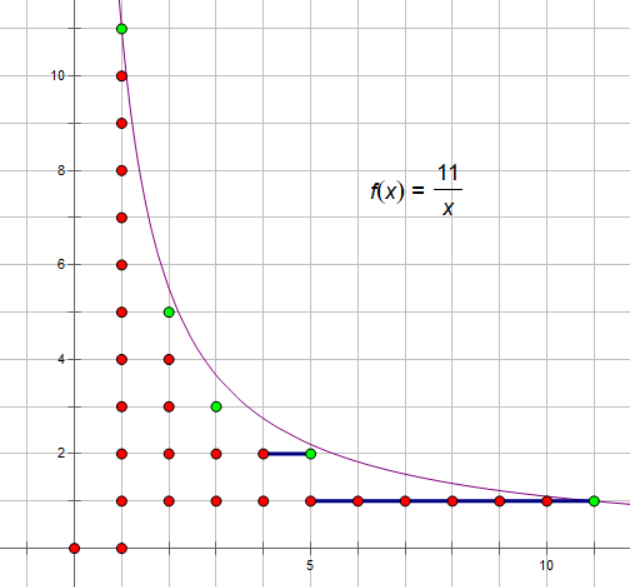万事俱备,则时空将会反演。
数论分块
字面意思,在数学论理中进行分块处理。一般用于快速计算含有向下取整和式的题。当可以在 $\mathcal O(1)$ 内计算出 $f(r)-f(l)$ 或者已经预处理除了 $f$ 的前缀和时,数论分块就能够使用 $\mathcal O(\sqrt n)$ 的时间内计算出类似于 $\sum\limits^{n}_{i=1}f(i)g(\lfloor \frac{n}{i} \rfloor)$ 的和式的值。
富比尼定理(Fubini’s theorem)
将 $\lfloor\frac{n}{i}\rfloor$ 打包计算。
又称“算两次”,以意大利数学家圭多·富比尼($\text{Guido Fubini}$)命名。 富比尼定理的积分形式:只要二重积分 $ \int\int|f(x,y)|dxdy$ 有界,则可以逐次计算二重积分,并且可以交换逐次积分的顺序。 积分号也是特殊的求和号,因此在一般求和中,富比尼定理往往呈现为更换计数顺序,即交换两个求和号。 组合数学中的富比尼定理表现为,用两种不同的方法计算同一个量,从而建立相等关系。这种方法在反比例函数上有很好的解释:

在区间 $[1,11]$ 中,根据 $y=\lfloor\frac{11}{x}\rfloor$ 的答案不同,被分成了 $5$ 块, $5$ 块整点的最大纵坐标都相同,
引理 Ⅰ
$\forall a,b,c\in\mathbb Z,\lfloor\frac{a}{bc}\rfloor=\lfloor\frac{\lfloor\frac{a}{b}\rfloor}{c}\rfloor$ ,证明详见 OI-Wiki
引理 Ⅱ
$\forall n\in \mathbb N_+,|\{\lfloor\frac{n}{d}\rfloor|d\in\mathbb N_+,d\leq n\}|\leq\lfloor2\sqrt n\rfloor$ ,证明详见 OI-Wiki
引理 Ⅲ
对于 $\forall i\le n,\lfloor\frac{n}{i}\rfloor$ 只存在 $\mathcal O(\sqrt n)$ 种不同的值。
对于 $i\le \sqrt n$ 的部分,$i$ 只存在 $\sqrt n$ 个,取值也不会超过 $\sqrt n$ 个;
对于 $i>\sqrt n$ 的部分,$\lfloor\frac{n}{i}\rfloor<\sqrt n$ ,取值也不会超过 $\sqrt n$ 个。
结论
对于常数 $n$ ,使 $\lfloor\frac{n}{i}\rfloor=\lfloor\frac{n}{j}\rfloor$ 成立的最大满足 $i\leq j\leq n$ 的 $j$ 的值为 $\lfloor\frac{n}{\lfloor\frac{n}{i}\rfloor}\rfloor$ 。即值 $\lfloor\frac{n}{i}\rfloor$ 所在块的右端点为 $\lfloor\frac{n}{\lfloor\frac{n}{i}\rfloor}\rfloor$ 。
简单证明:
因为有 $\lfloor\frac{n}r\rfloor=\lfloor\frac{n}{i}\rfloor$ ,则有:
$r\times\lfloor\frac{n}{i}\rfloor\le n$ ,变式得到:
$r\le\lfloor\frac{n}{\lfloor\frac{n}{i}\rfloor}\rfloor$ 。
证毕。
分块加速
那么,就如同对数组进行分块一样,对于每一个块的计算,我们就直接用块值乘以个数计算即可,用数论分块加速时间,降低时间复杂度。
例题
UVA11526
题意显而易见了。直接分块计算即可。记得开 long long 。
AC Code
1 |
|
Luogu 2261
这道题需要一点特判。
我们知道 $k\bmod p =k-\lfloor\frac{k}{p}\rfloor\times p$ ,那么,我们需要求的式子也可以转化为:
$ans=\sum_{i=1}^n k\bmod i=\sum_{i=1}^n k-\lfloor\frac{k}{i}\rfloor\times i=nk-\sum_{i=1}^n \lfloor\frac{n}{i}\rfloor\times i$
然后就转化为了数论分块的经典各式了。
对于这道题的特判,因为 $n$ 和 $k $ 的大小关系是不清楚的,而因为 $l\leq n$ 可能会存在 $\lfloor\frac{k}{l}\rfloor$ 为 $0$ 的情况,所以需要特判。
AC Code
1 |
|
N 维数论分块
不太能了解,也不大可能会考(刀我),如果感兴趣的可以自行去 OI Wiki 上浏览。
数论函数
数论函数是指定义域为正整数的函数。
积性函数
积性函数是一种特殊的数论函数,满足 $f(x,y)=f(x)\times f(y),x\perp y$ ,则 $f$ 是积性函数。显然满足 $f(1)=1$ 。
对于 $x\perp y$ 的理解
其实可以把它看作是 $x$ 的向量与 $y$ 的向量相垂直之类的(?感谢李姐。若 $f(x),g(x)$ 为积性函数,则:
$h(x)=f(x^p)$
$h(x)=f^p(x)$
$h(x)=f(x)g(x)$
$\displaystyle h(x)=\sum_{d\mid x}f(d)g(\frac{x}{d})$
中的 $h(x)$ 都是积性函数。
对于任意正整数 $x,y$ 满足 $f(xy)=f(x)\times f(y)$ ,则 $f$ 为完全积性函数。
常见常用的积性函数:
- 单位函数 $\epsilon(n)=[n=1]$ ,即当 $n=1$ 时 $\epsilon(n)=1$ ,否则 $\epsilon(n)=0$ 。
- 恒等函数 $id_k(n)=n^k,id_1(n)$ 通常简记作 $id(n)$ 。
- 常数函数 $I(n)=1$ 。
- 除数函数 $\sigma_k(n)=\sum_{d\mid n}d^k,\sigma_0(n)$ 通常简记作 $d(n)$ ,而 $\sigma_1(n)$ 通常简记作 $\sigma(n)$ 。
- 欧拉函数 $\varphi(n)=\sum_{i\le n}[\gcd(i,n)=1]$ ,常用的一个计算式是 $\varphi(n)=n\times \prod_{p\in \operatorname{Prime}}\frac{p-1}{p}$ 。
- 莫比乌斯函数 $\mu(n)$ ,当 $n=1$ 时,$\mu(1)=1$ ,当 $n>1$ 时,记 $n$ 的质因子分解为 $n=\prod p_i^{k_i}$ ,共有 $\omega(n)$ 种质因子,则当存在 $k_i>1$ 时,$\mu(n)=0$ ,否则 $\mu(n)=(-1)^{\omega(n)}$ 。
狄利克雷函数
狄利克雷生成函数
一个数列的狄利克雷生成函数(被称为 $DGF$ ) 被定义为:
$f_i$ 是一个从 $\mathbb N_+$ 到 $\mathbb Z$ 的函数,该生成函数与一个数论函数相对应,规定 $f_1=1$ 。
如果该函数是积性函数,(积性函数定义:对于所有互质的整数 $a$ 和 $b$ 有性质 $f(ab)=f(a)f(b)$ 的数论函数)即满足 $\forall i\perp j,f(ij)=f(i)\times f(j)$ ,则 $\tilde{F}(x)$ 可以由质数及其幂来表达,记作:(令 $P$ 为全体质数集合)
狄利克雷卷积
若数论函数 $f,g,h$ 满足 $h(n)=\sum_{d\mid n}f(d)g(\frac{n}{d})$ ,则称 $h$ 为 $f,g$ 的狄利克雷卷积。记作 $h=f\ast g$ 。
满足性质:
- 单位函数 $\epsilon$ 是狄利克雷卷积的单位元(幺元),即 $f\ast\epsilon=f$ 。
- 狄利克雷卷积满足结合律和交换律。即 $a\ast b=b\ast a,a\ast(b\ast c)=(a\ast b)\ast c$ 。
- 两个积性函数的狄利克雷卷积仍是积性函数。
性质三的证明类似于除数函数的积性证明。
逆元 · 重定义
在狄利克雷卷积的条件下,我们对逆元进行重定义:
满足 $f\ast f^{-1}= \epsilon$ ,则称 $f_{-1}$ 为 $f$ 的逆元。
如果 $f$ 是积性函数,则其逆元 $f^{-1}$ 也是积性函数。